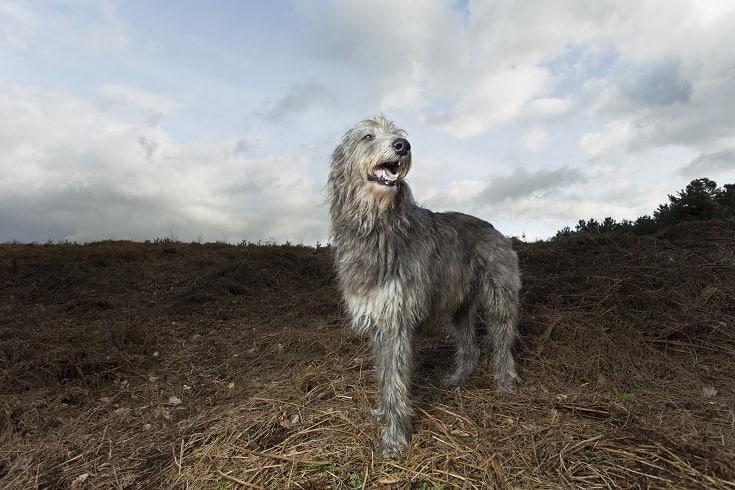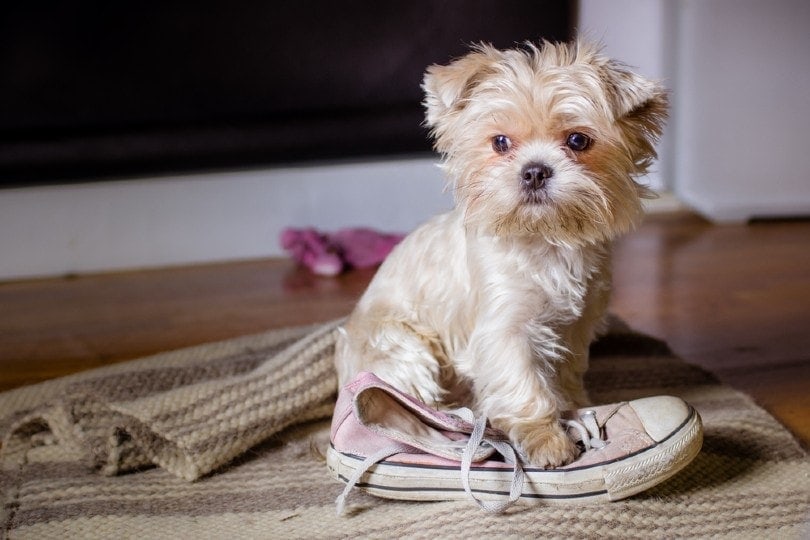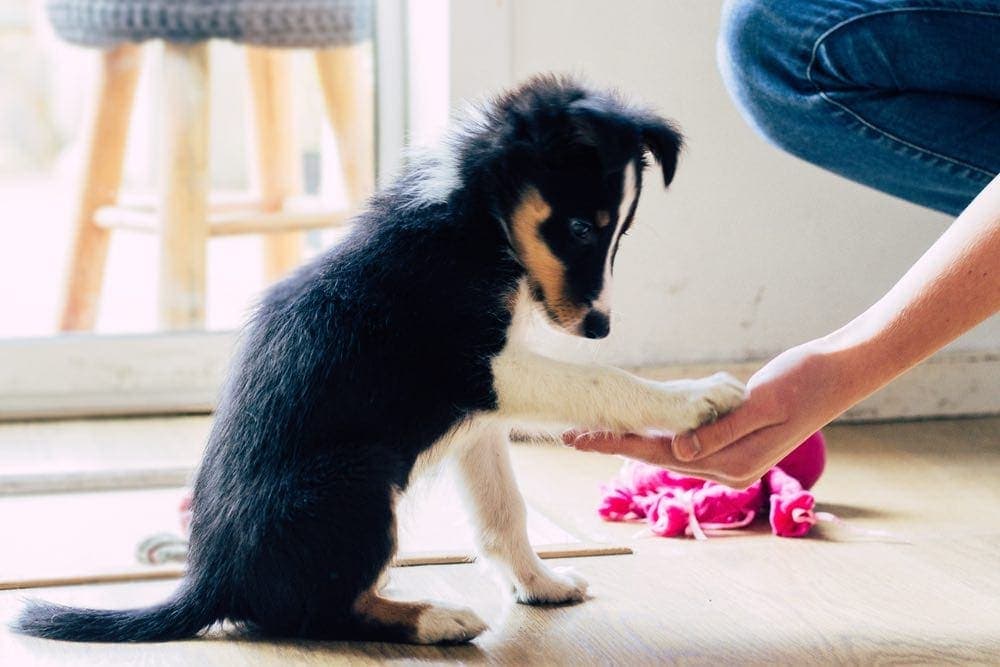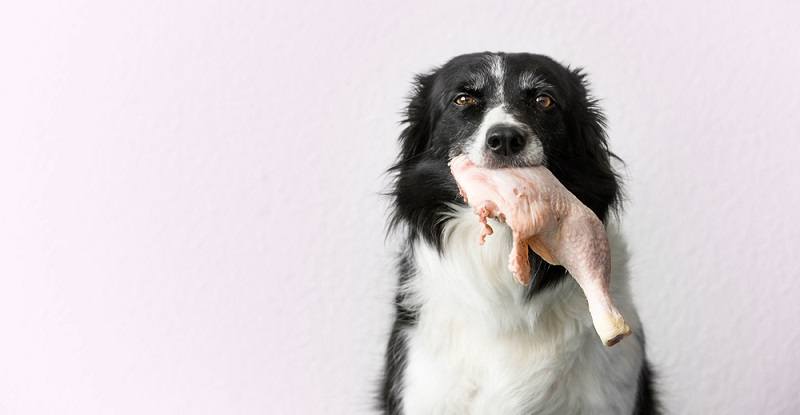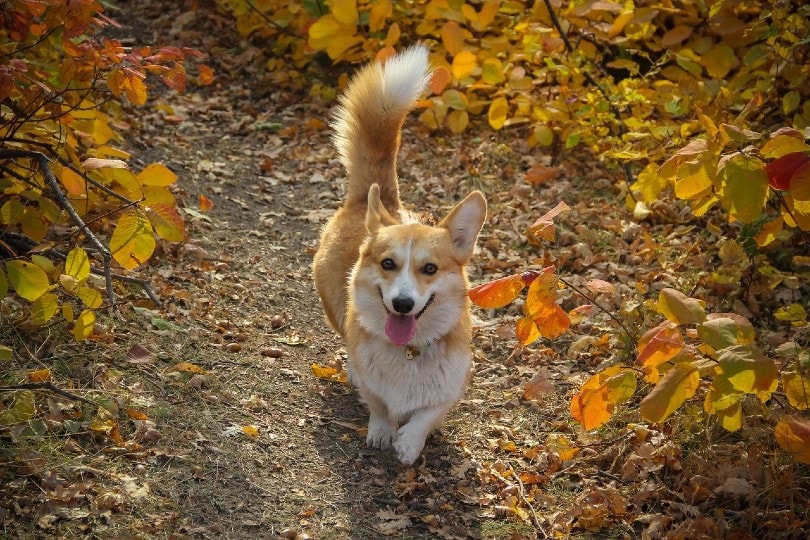| Height: | 26 – 32 inches |
| Weight: | 75 – 110 pounds |
| Lifespan: | 8 – 11 years |
| Colors: | Fawn, red, blue, and gray |
| Suitable for: | Active families, families with other large dogs |
| Temperament: | Gentle, Dignified, Polite, Laidback |
The Scottish Deerhound is an ancient and rare breed. It’s so old that we can’t separate its actual origin from legend and myth. It is suggested that these deer-stalking hounds were there before the Scots even got there.
These dogs evolved to stalk the local wild red deer – 400-pound animals with dangerous antlers. As you can imagine, these dogs have grown into massive animals to compensate. They’re muscular and bred to run for extended periods to catch their prey.
They were never bred to be companion dogs and, therefore, won’t act like your average canine today. They are not as affectionate as most but are extremely well-behaved inside. They are often described as laidback and polite, despite their love of running.
This is a unique breed for a unique family.
Scottish Deerhound Puppies – Before You Buy…
These dogs were made to run down colossal deer. Chasing deer requires a tremendous amount of energy, which these dogs still have today. Because of that, they require quite a bit more exercise than most breeds. They will not do well locked up inside all day with just a quick walk around the city.
Instead, you can expect these dogs to be moving the majority of the day. A big fenced in yard where they can run to their heart’s content is the best option.
Scottish Deerhound can be entirely independent. They do not listen to commands particularly well, though they are smart enough to learn quite a few. A Scottish Deerhound is much more likely to decide on his own course forward than listen to you. This is just how they are, and isn’t something you can “train out.”
Because these breeds were bred mainly for practical reasons, they are quite healthy. No one wanted an unhealthy hunting dog, so health was at the forefront for much of their breed’s history. They are prone to some genetic problems – like all dogs – but these problems are much less severe than other breeds.
Despite this, though, they usually don’t live for very long. It is widespread for big dogs to have shorter lifespans than their smaller cousins, and the Scottish Deerhound is a perfect example of that. They only live about 8-11 years, which is a bit shorter than most breeds.
These dogs are quite friendly. They aren’t as outgoing as other breeds. A Scottish Deerhound is not going to jump up to greet a stranger, for example. However, they are very gentle and polite when appropriately socialized. They can behave exceptionally well in a house.
With that said, their size can be a bit intimidating. Still, they are not likely to be aggressive and do not have strong guarding instincts.
What’s the Price of Deerhound Puppies?
The price can vary somewhat depending on your location. Scottish Deerhound are most commonly in Scotland and Britain. If you live in these areas, you can probably find one for a bit cheaper than most.
However, if you live in the USA, you’ll probably going to have to pay a bit more. Most breeders are going to charge a few thousand dollars for their puppies.
Because these dogs are somewhat rare, it can also be challenging to find a breeder near you. Luckily, there are quite a few in the states and around the world currently. Still, you may have to drive a bit to pick up your puppy, so be sure to keep that in mind when considering adopting one.
Furthermore, because these dogs are so big, their equipment tends to be a bit expensive as well. You’ll need to invest in a large dog bed, plenty of food, and toys that can withstand such a mighty dog. This can cost quite a bit of money up front and down the line. Be sure to budget this into your dog’s final cost.
3 Little-Known Facts About the Scottish Deerhound
1. The Scottish Deerhound was so prized it almost went extinct.
One of the reasons the Scottish Deerhound is so rare is because there were once a series of policies involving who could own one. At one point, no one under the rank of an earl could own a Scottish Deerhound. This restricted the number of potential owners and almost caused the breed to become extinct.
Luckily, though, the breed bounced back and is nowhere near extinction today.
2. Scottish Deerhound usually hunt by themselves.
Unlike what you might expect from a canine, Scottish Deerhounds do not hunt in packs. They often hunt by themselves or in pairs at the very most.
3. Scottish Deerhound possess instinctual hunting abilities.
In other words, Scottish Deerhound doesn’t have to be trained to hunt. They do it automatically and instinctually. This is one of the reasons they are so valuable.
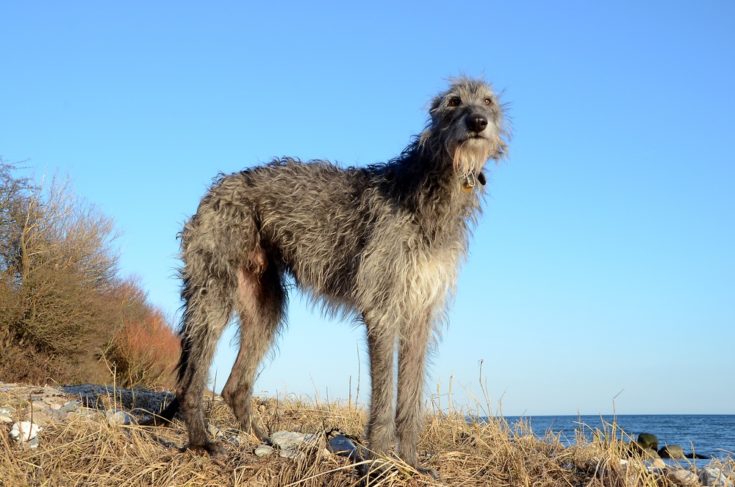
Temperament & Intelligence of the Scottish Deerhound
The Scottish Deerhound is best described as a “gentle giant.” Yes, they are enormous. However, they do not have significant guarding instincts and aren’t particularly territorial. Because of this, they are quite a bit less aggressive than some other breeds.
Still, they do require quite a bit of socialization. They have significant prey-instinct and will chase other animals (and occasionally children). Early socialization can help with this somewhat.
Still, their drive to chase is instinctual and will never go away completely.
This canine is not aggressive towards strangers but isn’t particularly outgoing either. They tend to be a bit standoffish until they warm up to their new friend. Depending on your situation, this can be a good thing or a bad thing.
On the one hand, they aren’t going to love everyone they meet. On the other hand, though, these dogs aren’t going to try and jump on everyone who enters your home. They’re a dog you can expect to lay comfortably on their bed when company arrives.
They are gentle and tend to be exceptionally well-behaved indoors. Still, Deerhounds don’t like staying inside all day. They need room to run – which most homes just don’t provide. A fenced-in backyard that allows them to run when needed can be a huge asset.
Are These Dogs Good for Families?
For the most part, these dogs can make excellent family dogs. They are very gentle with children as long as they are socialized early. Furthermore, they are so large that you don’t have to worry about a toddler accidentally injuring them (and then getting snapped at). They can generally put up with a bit of nonsense from younger children.
Still, playtime should be supervised. They like to run and are very large. Occasionally, they can knock others down, which can potentially cause injuries.
They are not one-person dogs, so they will bond tightly to everyone in our household. They are not as affectionate as some other dogs, but they are responsive to attention.
Does This Breed Get Along with Other Pets?
Not really. They have powerful hunting instincts and will chase other animals. They aren’t aggressive, but they have been known to terrorize unknown animals by chasing them around.
Early socialization can help with this. If introduced to other dogs and cats early one, they can live peacefully in a house with them. Dogs of a similar size and activity level are the best playmates.
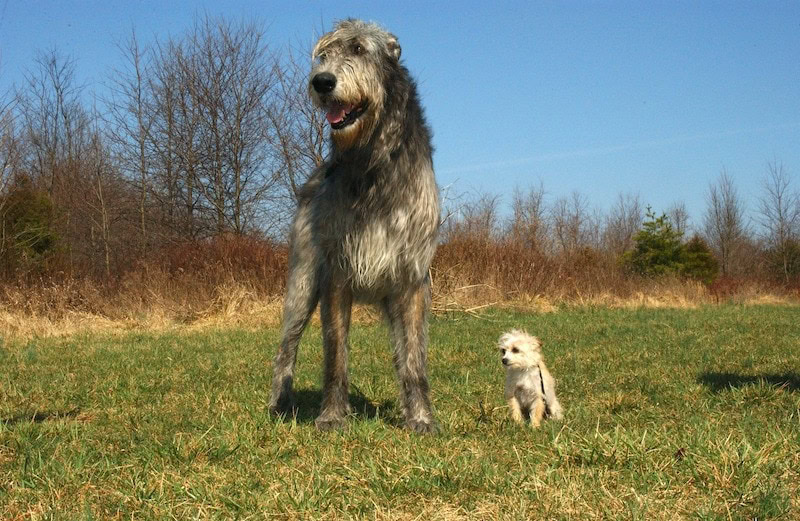
Things to Know When Owning a Scottish Deerhound
Food & Diet Requirements
Scottish Deerhounds eat a lot and require a lot of exercise to stay in shape. What they eat is extremely important to their overall wellbeing and lifespan.
Scottish Deerhound puppies grow very quickly and need specialty dog food. It is not enough to ensure that these puppies are given a puppy dog food – they need one specifically designed for larger breeds. These particular recipes can cost a bit more money since they are often more calorie and nutrient-dense. Be sure to keep this in mind when budgeting in food for your new pooch.
This breed is not particularly prone to becoming overweight. They do require a bit of exercise, though, and may become obese if they don’t get it. Watching their calories is also important. Ensure you follow the feeding directions on the dog food you’re feeding your pooch. Monitor their body condition so that you can turn their weight gain around before it gets too severe.
Exercise
These dogs need to run. They were bred to chase down deer and still have this boundless energy today.
It can be challenging to raise these dogs to their full potential without a similarly sized playmate. A large, fenced-in area is also essential to their wellbeing – unless you plan on hiking for miles every day.
Some very active families can raise Deerhound successfully without these things. However, most families are going to need some sort of playmate and a secure area for them to play. This is not a breed you can leave in a crate while you work all day. These dogs need to be able to do what they were bred to do – run.
Dogs that do not get their required exercise each day will become destructive. Because these dogs are so large, this can be a huge problem. You do not want a 60-pound deerhound deciding that it wants to eat your couch (or dig under your fence).
While they are growing, forced exercise should be avoided, though. Puppies need to exercise on their terms, or they may risk injury. Playing things like fetch in an enclosed area is a better exercise idea than taking a run at this age.
Older hounds might enjoy lounging around in the sun instead of getting exercise. However, physical activity is required for them to live their full lifespan. Encourage your dog with fun games and plenty of time outside.
Training
These dogs likely aren’t going to be winning any obedience competitions anytime soon. They are somewhat intelligent (more so than some other breeds), but they were not bred to listen to orders – and usually don’t as companion animals.
This problem arises from the fact that Scottish Deerhounds automatically know how to hunt. They don’t have to be trained to do it. So, while their breed was getting established, no one particularly cared if they listened to commands. As long as they could hunt, they were a good dog, and their genes got passed on.
Today, that leaves you with a dog breed that loves to run and only listens to commands when they want to. They are quite stubborn.
However, this doesn’t mean they are untrainable. You just can’t expect them to listen to your commands as a Border Collie would. They have a mind of their own.
Grooming ✂️
While these dogs might be a handful when it comes to exercise, their coat is straightforward to care for. They evolved to withstand the harsh climate of Northern Scotland, which led to their coat being quite wiry and weather-resistant.
They do not need a bath unless they get physically dirty (like running in the mud, for instance). You may want to brush your dog’s coat once a week or so to keep mats at bay. Besides that, though, you don’t have to do much. You’ll need a slicker brush, fine-toothed metal dog comb, and an electric nail grinder at the most.
In many cases, they’ll need their nails cut regularly. This can be done yourself, or you can take them to a groomer.
They don’t need their ears cleaned regularly, but you should still keep an eye on them. Dirt and dead skin can build up in their ears and cause an infection, so just take a wet cotton ball to their ears if they get dirty.
Health and Conditions
Like all breeds, these dogs are prone to a few different health conditions. Luckily, though, they are very healthy dogs.
Here are some of the most common health conditions they’re prone to, as well as a description of some of the most common disorders.
- Cardiomyopathy
- Allergies
- Hypothyroidism
- Gastric Torsion
- Osteosarcoma
- Anesthesia sensitivity
Gastric Torsion
Gastric Torsion is also referred to as Bloat. The twisting of the stomach characterizes this disorder, which usually occurs because the stomach has filled with gas. This is a severe and deadly condition.
The cause of this disorder is known. Many potential causes have been put forth, but none have been proven. There are many likely triggers. Larger dogs tend to be more prone to it than smaller dogs, for whatever reason.
Symptoms include pacing, general discomfort, trying to vomit without success, increase saliva production, and bloating are the most common symptoms. Treatment almost always involves surgery. Often, the stomach will be fastened to the abdominal wall to prevent it from happening again.
Some vets recommend that your Scottish Deerhound’s stomach be fastened to their abdominal wall while they’re being fixed. This surgery prevents this disorder altogether.
Osteosarcoma
Osteosarcoma is a type of bone tumor. It usually appears in the limbs, but it can show up in any bone. Rarely, this type of tumor might even show up in non-boney areas, like muscles.
Often, this form of cancer is very aggressive. 90-95% of dogs with these tumors will develop cancer cells in other parts of their body as well, even if they aren’t detectable.
No one knows precisely what causes this type of cancer, but it appears some of it is genetic. The best way to ensure that your pooch won’t be affected is to ask questions about cancer before adopting any puppy. If a puppy’s direct relative has had this disorder, there is a chance that they may be more prone to getting it as well.
Lameness and weakness in the affected limb are the most common symptoms. Fractures can occur if the bone has weakened enough.
Treatment almost always involves amputation and then chemotherapy.
Anesthesia Sensitivity
Scottish Deerhounds tend to be more prone to anesthesia sensitivity than other breeds. This is not necessarily a problem in your pet’s everyday life, but it can lead to severe consequences if your pet ever needs surgery.
For an unknown reason, Greyhounds and other sighthounds seem to be more prone to anesthesia sensitivity. In particular, they seem to be sensitive to Propofol, which is a prevalent anesthesia drug in the United States.
There is some evidence that this sensitivity is caused by lean-muscles distribution. Basically, in dogs that are lean and tall, there is a problem with the distribution of the drug. This creates a higher concentration in a dog’s plasma, as opposed to their adipose tissue.
Males vs. Females
Male Scottish Deerhounds are noticeably larger than their female counterparts. Males get much larger than females in most cases, so keep this in mind when adopting a puppy.
There isn’t much temperament difference between the two, however. Both sexes are pretty laidback and gentle. Males are not particularly territorial or protective.
Final Thoughts
Scottish Deerhounds are unique dogs that need a unique family. They have high activity needs but need little to no grooming. These dogs aren’t particularly loveable, though they are gentle and do well with children.
These dogs do best in homes with active companions and playmates. They don’t do well with cats and other small animals, so you may have to look elsewhere if you already have these furry friends in your life.
Featured Image Credit: Jamie Hall, Shutterstock

